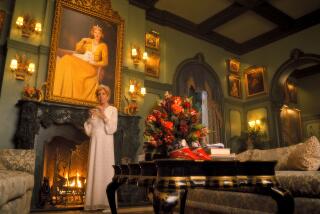They’re persnickety
It’s not set in a particular period or place, nor is it quite contemporary, yet it looks oddly if fantastically familiar, like the more vividly stylized fragments of a vaguely remembered dream. A parallel universe. That what the production designer and set decorator of “Lemony Snicket’s A Series of Unfortunate Events” were going for, a parallel universe, one that that subverts time, location and place. A universe they describe as “Victorian expressionism.”
It’s also a universe that recalls the magic and inventiveness of “The Wizard of Oz” or the ‘40s Technicolor extravaganzas such as “The Pirate” and “Yolanda and the Thief” of director Vincente Minnelli.
Just as with those classic films, the sets, decorations and costumes of “Lemony Snicket” engage viewers’ imaginations and transport them to this anachronistic world.
Oscar-winning production designer Rick Heinrichs (“Sleepy Hollow,” the “Planet of the Apes” remake) and veteran set decorator Cheryl A. Carasik spent months before a single frame was shot, scouting locations, transforming soundstages and stalking flea markets to bring “Lemony Snicket” to life.
“We tried to create a movie that was more faithful to the spirit” of the books, says Heinrich. “Daniel Handler writes in a lot of anachronistic elements. If you look at contemporary culture it is a cacophony of things that have gone before. We started in a place we called Victorian expressionism, which seems like a bit of an oxymoron, and then threw things from the Edwardian era to the mid-20th century.”
Among the indelible images created for the film: the decrepit, Dickensian and highly theatrical abode of the villainous ham actor Count Olaf; the warm, open, reptile-filled home of scientist Uncle Monty; the creaky, rickety wooden house of Aunt Josephine that was designed to resemble a camera on a tripod; an isolated general store jammed with knickknacks and food items; and the mysterious clock tower where journalist Lemony Snicket works.
The eye motif that’s so important in Handler’s Lemony Snicket books -- the eye is the icon for a secret organization -- is subtly prevalent in nearly every scene.
The movie was shot on the soundstages in Paramount, but all the scenes involving water were filmed at an old Boeing factory in Downey were the space shuttle was made.
“At Paramount it was kind of difficult working because it is an old studio,” Heinrich explains. “It has narrow alleyways between stages and stages weren’t huge. So we were literally building from one stage into the next and opening doors in between.”
Carasik began working on the set decorations as soon as she had her first discussion with Heinrichs and director Brad Silberling.
“I was familiar with the drawings from Daniel Handler’s books,” she says. “I sat down and read the three books. I love reading books that are really expressive like that because you can take your imagination and just run with it. He is pretty specific about being able to, in his dialogue, explain where they are. So for me as a decorator, it is visual input for me. I knew I was going to be able to bring some of those thoughts to fruition. It was basically getting down a style.”
For Olaf’s house, she transformed a Louis XV chair into something akin to a throne.
“We also have Empire Edwardian chairs and we have some Moorish Flemish chairs. Since he is an actor everything could have a theatrical flair to it.”
For a frayed wall hanging, Carasik took expensive fabric she bought at the Pacific Design Center and used a process called acid etching to make it look deteriorated with age. “It’s a process that eats away the natural elements of the fabric,” she says. “It just made this material that was quite beautiful look like it was shredded and hanging there for 100 years.”
She even acid-etched the eye motif into the velvet wallpaper that decorates the walls. She added another eye to the Louis XV chair. “I did some research on eyes, and that actually was from an old photograph of an old image. It is a religious motif and we just added a whole bunch of lines to it. The eye was treated with a process where after the eyeball is sewn into the fabric, they inject foam into it to puff it out.”
Heinrich got his inspiration for Olaf’s overstuffed, decrepitly sinister home from David Lean’s classic atmospheric 1940s film versions of Charles Dickens’ “Oliver Twist” and “Great Expectations,” with a bit of New England Puritanism thrown in for good measure. The spiraling staircase that dominates the house is a tip of the hat to the staircase Norma Desmond descends in “Sunset Boulevard.”
Olaf’s coldly unwelcoming home is far different from Uncle Monty’s embracing and nurturing abode, reptiles notwithstanding. Heinrichs wanted an Arts and Crafts sensibility in the house. He reinforced the idea of Monty’s love for snakes by spotlighting the arches in the rooms. “The snake anatomy was an inspiration for a lot of it,” he says.
Thanks to the Internet, Carasik was able to buy cages for the snakes from all around the world. “In his house, I think there were at least 35 cages and in a warehouse we had an additional 15 or 20 that we didn’t use. They were all and every one unique and had to be changed a little bit. The more modern ones had to be sanded down to look old.”
The interiors, she adds, reflect Monty’s warm, open personality.
“There’s a fire in the fireplace and candles burning,” she says. “We did a lot of texture. It was a nice combination of Moorish and Arts and Crafts.”
Despite all the planning, sometimes Heinrichs had to pull a rabbit out of his hat -- in one case, it was a snake.
Just two days before shooting began on the Uncle Monty set, Silberling decided he wanted massive snake sculptures decorating the garden of the house.
“They were sculptured from foam,” Heinrichs says. “Then we actually took pottery and smashed it and laid it on top” of the sculpted forms to make them look like mosaics.
“It was one of those things where you go, ‘OK. We have to do it now.’ We were so happy that we pulled it off.”
More to Read
Only good movies
Get the Indie Focus newsletter, Mark Olsen's weekly guide to the world of cinema.
You may occasionally receive promotional content from the Los Angeles Times.









